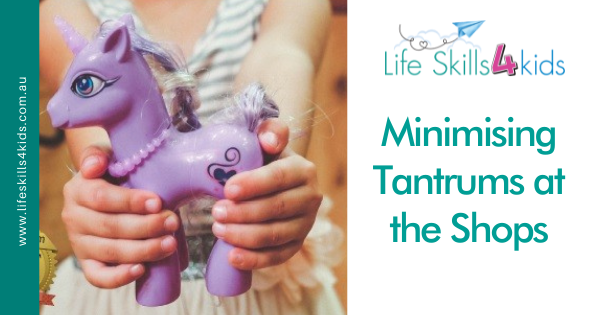Minimising Tantrums at the Shops Part 2
All parents understand the struggle and balancing act that shopping with children can be. In last month’s edition of GHG (TM), we took a look at some of the less understood reasons why shopping can be so hard for children. We recommend reading this article to gain a good understanding of why shopping can be difficult.
There are many ideas that can make the job of shopping with children much easier and even an enjoyable and connecting time with your child. Take a look at some of our ideas below and give them a go!
TIPS FOR MAKING SHOPPING TRIPS EASIER:
1. Involve your child in the planning process. Before you head to the shops, talk about what you need to buy. As you make your shopping list, talk about what items your child will be able to help to find. Grab some old catalogues and cut out some pictures of foods that you buy weekly e.g. bread, milk, apples, bananas etc.
2. Create a little ‘shopping list’ for your child. Give them some responsibility. You could laminate the pictures and put them on a laminated card, in a small photo book or in a little wallet/purse for them to look after and be
responsible for. Once you get to the shops, go to a section or aisle and say, ‘Now, what’s on your list to buy here?’ Give a clue, ‘Can you see the bananas around here?’ Help your child choose the correct amount and let them
be hands on in getting items from the shelf.
3. Ask your child if they find the noise or lights too much or too bright? Some children are self-aware and can tell you. If lights are an issue, let them try wearing some kid’s sunglasses inside the shop. If it’s too noisy, try some kids-sized ear muffs.
4. Prepare your child’s nervous system before getting to the shops. Take a detour for 10 minutes on the way to the park. Let them swing, climb and run around. Not only does this ‘burn energy’ but it helps fill their nervous
system with movement input that will then allow them to focus, self-regulate and be more in control of their behaviour.
5. If you can’t get to the park on the way, have some sensory tools in the car they can use. This might include wearing sunglasses in the car, pulling on some exercise band in the back seat (muscle resistance input is calming and organising), or fiddling with a fidget toy.
6. Back yourself as a parent and set guidelines for rewards. Kids often ask for treats during shopping. Don’t get sucked into always buying something to keep the peace. Children will push the limits every time and they need to learn that often the answer is ‘no’. If you want to say no, say, ‘no’, and stick to your guns. You may get tantrums or complaints the first time or two, but you need to think of the bigger picture and pick your battles. It will get easier, but you need to be consistent.
7. Try and pick times of the day. Certain times will be more successful, especially for younger children. Sometimes it’s unavoidable, but try and go when a child is well-rested, not hungry and you have enough time.
Kids today are growing up in a fast-paced world where information and opportunity overload can be overwhelming.
Based on many years of clinical experience as an Occupational Therapist, Deb Hopper has been using her Just Right Kids® Model to teach children to communicate and manage their stress and anxiety by:
- Identifying their “body speed”,
- Understanding their stress triggers, and
- Implementing simple strategies to reduce anxiety and stress.



